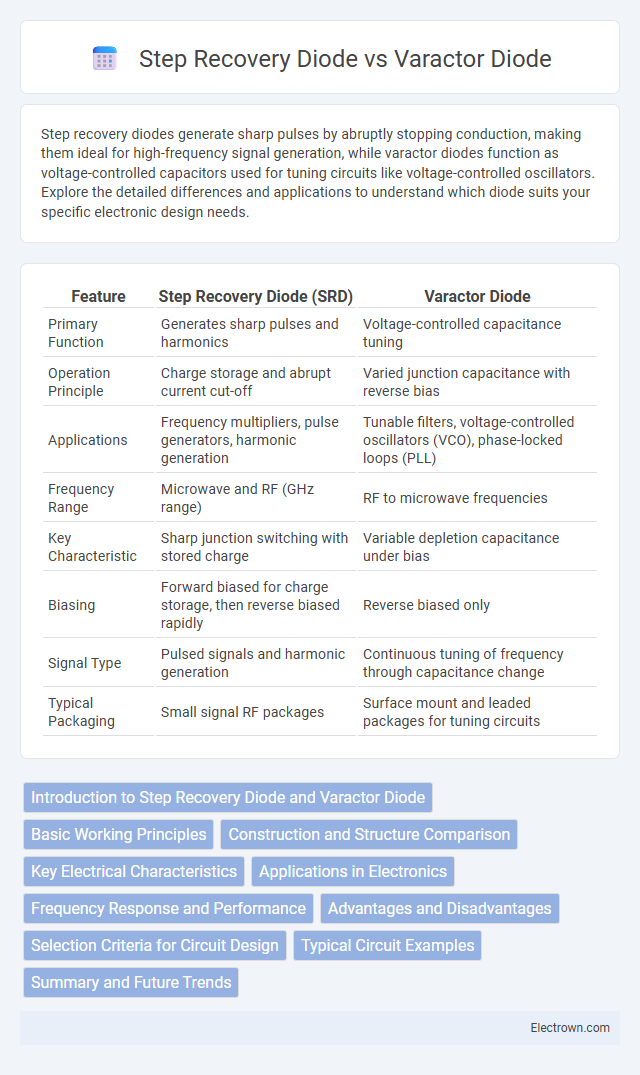Step recovery diodes generate sharp pulses by abruptly stopping conduction, making them ideal for high-frequency signal generation, while varactor diodes function as voltage-controlled capacitors used for tuning circuits like voltage-controlled oscillators. Explore the detailed differences and applications to understand which diode suits your specific electronic design needs.
Table of Comparison
| Feature | Step Recovery Diode (SRD) | Varactor Diode |
|---|---|---|
| Primary Function | Generates sharp pulses and harmonics | Voltage-controlled capacitance tuning |
| Operation Principle | Charge storage and abrupt current cut-off | Varied junction capacitance with reverse bias |
| Applications | Frequency multipliers, pulse generators, harmonic generation | Tunable filters, voltage-controlled oscillators (VCO), phase-locked loops (PLL) |
| Frequency Range | Microwave and RF (GHz range) | RF to microwave frequencies |
| Key Characteristic | Sharp junction switching with stored charge | Variable depletion capacitance under bias |
| Biasing | Forward biased for charge storage, then reverse biased rapidly | Reverse biased only |
| Signal Type | Pulsed signals and harmonic generation | Continuous tuning of frequency through capacitance change |
| Typical Packaging | Small signal RF packages | Surface mount and leaded packages for tuning circuits |
Introduction to Step Recovery Diode and Varactor Diode
Step recovery diodes are semiconductor devices designed to generate sharp pulse edges by utilizing charge storage and abrupt current interruption, making them ideal for high-frequency switching and waveform shaping. Varactor diodes function as voltage-controlled capacitors, where their capacitance varies with the applied reverse bias voltage, enabling tunability in RF circuit applications such as voltage-controlled oscillators and frequency multipliers. Understanding the distinct operational principles of step recovery and varactor diodes helps you select the appropriate component for high-speed pulse generation versus variable capacitance requirements in electronic design.
Basic Working Principles
Step recovery diodes operate by abruptly stopping current flow when switching from forward to reverse bias, generating sharp voltage pulses used in high-frequency applications. Varactor diodes function as voltage-controlled capacitors, changing their capacitance in response to varying reverse bias voltage for tuning circuits. The key difference lies in step recovery diodes utilizing charge storage and abrupt recovery effects, while varactor diodes exploit junction capacitance variations for frequency control.
Construction and Structure Comparison
Step recovery diodes exhibit a layered pn-junction with a carefully doped abrupt transition, designed to store and release charge rapidly, enabling sharp pulse generation. Varactor diodes feature a reverse-biased pn-junction with a uniformly doped depletion region, optimized for voltage-dependent capacitance variation essential in tuning circuits. The structural difference lies in the step recovery diode's charge storage capability from its abrupt doping profile, contrasting with the varactor diode's gradual junction enabling precise capacitance control.
Key Electrical Characteristics
Step recovery diodes exhibit sharp transient response with rapid storage time and high switching speed, making them ideal for pulse generator circuits and frequency multipliers. Varactor diodes provide voltage-dependent capacitance, allowing frequency tuning and voltage-controlled oscillation with low series resistance and high quality factor. Key electrical characteristics such as junction capacitance variation in varactors contrast with the abrupt charge storage and release behavior that defines step recovery diodes.
Applications in Electronics
Step recovery diodes excel in high-frequency pulse generation and frequency multiplication due to their ability to generate sharp voltage transitions, making them indispensable in microwave circuits and frequency synthesizers. Varactor diodes are primarily used in voltage-controlled oscillators, phase-locked loops, and tunable filters, where they exploit their voltage-dependent capacitance for frequency tuning and modulation. Both diodes are critical components in RF communication systems, with step recovery diodes optimizing signal shaping and varactor diodes enabling dynamic frequency control.
Frequency Response and Performance
Step recovery diodes exhibit sharp pulse generation with extremely fast switching, making them ideal for high-frequency applications up to several gigahertz. Varactor diodes provide voltage-controlled capacitance, enabling precise frequency tuning but with slower response times compared to step recovery diodes. Your choice depends on whether you prioritize rapid frequency multiplication (step recovery diode) or continuous frequency tuning (varactor diode) for optimal performance in RF circuits.
Advantages and Disadvantages
Step recovery diodes offer fast switching speeds and high-frequency generation, making them ideal for pulse shaping and harmonic generation applications. Varactor diodes provide voltage-controlled capacitance, enabling efficient tuning in frequency modulation circuits, but they have limited power handling and slower response times compared to step recovery diodes. Your choice depends on whether you prioritize high-frequency pulse performance or adjustable capacitance for tuning purposes.
Selection Criteria for Circuit Design
Step recovery diodes are ideal for generating sharp pulses and high-frequency harmonics due to their fast charge storage and abrupt transition characteristics, making them suitable for frequency multipliers and pulse generators. Varactor diodes provide voltage-controlled capacitance, making them essential in tunable circuits like voltage-controlled oscillators and phase-locked loops, where precise capacitance variation is required. Selection criteria depend on application needs: choose step recovery diodes when rapid switching and harmonic generation are critical, while varactor diodes are preferred for tuning and frequency modulation through voltage-controlled capacitive changes.
Typical Circuit Examples
Step recovery diodes are commonly used in pulse generators and frequency multipliers due to their ability to produce sharp voltage transitions, typically found in high-speed switching circuits and harmonic generators. Varactor diodes serve as voltage-controlled capacitors in tuning circuits, such as voltage-controlled oscillators (VCOs) and phase-locked loops (PLLs), enabling frequency modulation by varying the reverse bias voltage. Your circuit selection depends on whether the application requires abrupt switching for harmonic generation or smooth capacitance variation for frequency tuning.
Summary and Future Trends
Step recovery diodes are primarily used for generating sharp pulses and high-frequency harmonic signals, while varactor diodes function as voltage-controlled capacitors in tuning circuits and frequency modulation applications. Emerging trends include the integration of step recovery diodes in ultra-fast signal processing and the development of varactor diodes with enhanced linearity and higher quality factors for advanced wireless communication systems. You can expect future advancements to focus on improving device efficiency and expanding applications in 5G and beyond.
Step recovery diode vs varactor diode Infographic

 electrown.com
electrown.com